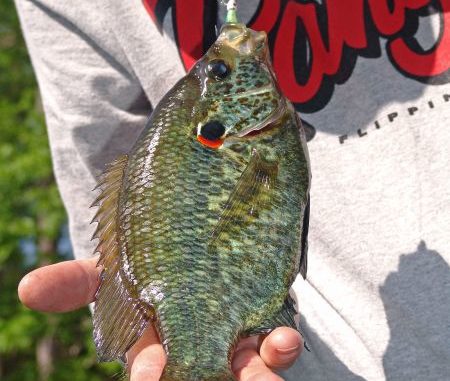
Aggressive and gluttonous as any schooling fish, chinquapin are hardly picky. Nevertheless, catering to their tastes and preferences will earn you more love.
Here are some thoughts:
Natural Baits
A hungry chinquapin won’t turn down a cricket or grass shrimp, but given their natural tendency to forage on freshwater mussels — hence, the name “shellcracker” — these fish hold a great fondness for worms.
Similar in consistency to those mollusk meals, an active wiggler worm won’t last long in the midst of a ’cracker convention.
Glynn “Catch” Cormier uses wigglers now and then, but he prefers plumper, meatier cold worms. With these beefy baits, he’ll use only a chunk to avoid feeding the fish free samples.
A smaller piece, he said, forces them to commit and grab the hook.
For his worm presentations, Cormier employs two rigging options:
• Small Jigs — Impaling a chunk of worm on the point of a 3/16-ounce jighead allows him to bump along the bottom to feel for those hard spots and locate feeding fish.
“I like to work the jig and keep it moving,” Cormier said. “I think they like a more-active presentation.”
• Modified Dropshot — Starting with a 1/8- to 1/4-ounce egg sinker, Cormier runs his line through the weight, brings the tag end up and ties a uni knot around the standing end.
Before tying the knot, he pulls through enough line to leave about a 6-inch tag end from which he’ll tie a No. 8 cricket hook.
“This rig lets me fish right along the bottom, but the leader gets the bait away from the sinker,” Cormier explained. “You need a long-shank hook because the fish might swallow the hook and I need to get it out.”
Artificials
From small tubes, to tiny crawfish bodies, soft plastics on 3/16-ounce jigheads will tempt any redear.
DOA’s 2-inch shrimp looks a lot like the grass shrimp panfish love, so pulling this bait across the right spots on a split-shot rig or a light Carolina rig will surely get some attention.
“One of my favorite artificials is a 1/32-ounce beetle spin,” Cormier said. “If the fish are sluggish, I may tip it with a piece of worm. They seem to hit it off the bottom as it’s coming back up.”
In the Atchafalaya Basin, McCardy has developed a dependable technique that enables him to hold an enticing bait in the target zone around those cypress roots.
“I use a brown-and-orange hair jig, and I tip it with a chartreuse (Berkley Powerbait) Crappie Nibble,” McCardy said. “I fish the jig under a slip cork. We’ll peg the cork so the jig is 2 to 5 feet beneath the cork, depending on the river level.
“If I have someone on the boat that doesn’t want to use the Crappie Nibble, I can usually out-fish them 8 or 10-to-1 by tipping my jig.”
Casting to the base of a cypress tree, McCarty gives his cork a pop to make the jig hop, action that grabs fish’s attention.
Flies
Cormier mostly uses heavily weighted flies and little micro jig flies that reach bottom quickly.
Among his favorites are the Fluff Butt and the Bead Head Hare’s Ear. Made of rabbit fur, the latter sports a lot of subtle motion that fish seem to like.
For all of his fly work, Cormier uses a 5-weight rod because it affords him optimal flexibility with the types of flies he uses.
A standard floating line does the trick, even for bottom-oriented fish.
“There’s no need to get down deeper than 4 to 5 feet because the most-active fish will be in the first few feet off the bottom,” he said. “So if you use a long-enough leader, you’ll be fine.
If I need to reach deeper, I’ll use a sink tip connector because it’s just easier to work with.”
Slowly stripping the fly, Cormier expects most strikes to occur right on the strip. He’ll typically count down to about 10 before he starts stripping.
In most cases, that initial movement is what flips the switch.
“In clear water, I’ve watched (chinquapin) gather around the fly and look at it,” Cormier said. “As soon as you move it, one will rush out and grab it.”


